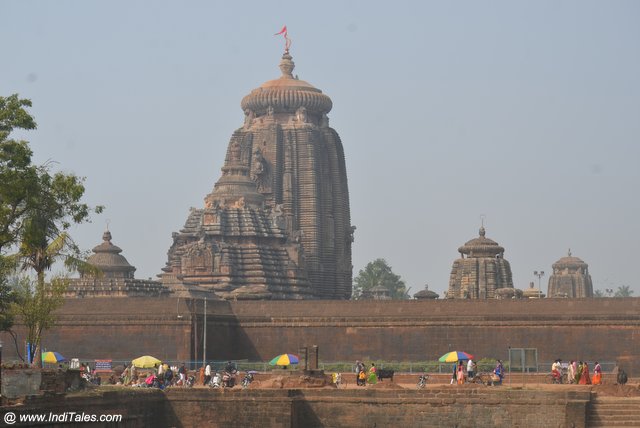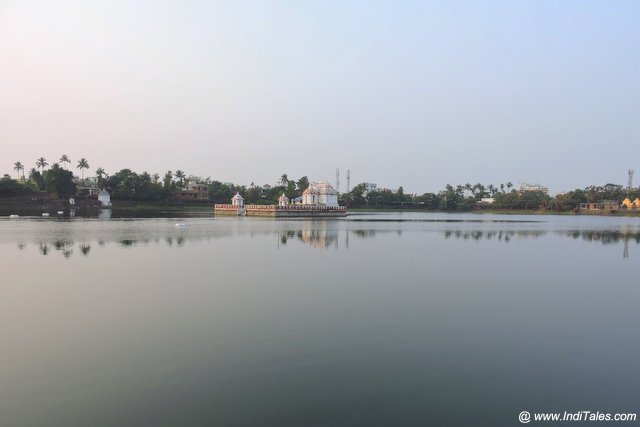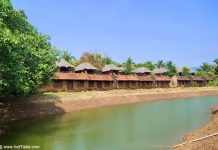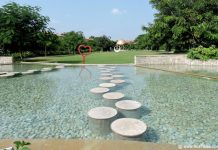My first introduction to Lingaraja Temple in Bhubaneshwar was during my course on Indian Art at National Museum. In a lecture on the North Indian Nagara Style of temple architecture, the Lingaraja temple was shown in detail as the best example of Nagara temple architecture. As the speaker explained each and every aspect of this grand temple, a desire to visit it took birth inside me.

It took a few years before I could visit the temple. The sheer size of the temple and the temple complex invokes a sense of awe. Our guide first took us to the viewing pedestal from where you get a landscape view of the temple. It was built for the British rulers who were not allowed to step inside the temple. Yes, this is one of those few temples where only Hindus are allowed. The platform just gives a vantage view that does not get from inside the temple.

What you see is a series of small temples surrounding the big temple in the middle. Devotees are moving around the premises going from one temple to another.
History of Lingaraja Temple
Odisha has four prominent sacred regions called Shankha, Chakra, Gada, and Padma inspired by the four Ayudhas of Mahavishnu. Bhuvaneshwar falls in the Chakra Kshetra. It is also known as Ekamra Kshetra which refers to a Mango tree and probably means that the original temple was beneath a Mango tree. Remember Kanchipuram also has a temple called Ekambareshwar dedicated to Shiva.
Who Built Lingaraja Temple?
The earliest evidence dates the temple to the early 7th CE when it was built by the Keshari kings. The major parts of the temple though date back to 11th CE by Yayati or Jajati Keshari of the Somvamshi dynasty who moved his capital from Jajpur to Bhubaneshwar.
Remember this is the time when the most magnificent temples like Kandariya Mahadev in Khajuraho and Brihideeshwara in Thanjavur were being built.
Nagara Architecture – Lingaraja Temple
Lingaraja temple is one of the biggest Hindu temples with its compound measuring 520 X 465 feet. It is an east-facing temple built in Sandstone and laterite. Built in the typical Kalinga Nagara architectural style or Deula style it has all the components of this style. The Vimana or Garbh Griha is the tallest, followed by Jagmohan or the Mandapa, followed by a Natyamandapa or the dancing hall, and finally Bhog Mandapa or the hall of offerings. All of them have roofs in decreasing order of height.

Surrounded by a tall wall or Prakara, the temple is actually a complex of 150 or so small temples. This follows the tradition of having all the Tirthas represented in the local tirtha. This also implies that despite being a royal temple, this temple is a sacred Tirtha. The Temple of Bhagawati is located in the northwest corner of the temple. I remember seeing a lot of ancient Shivalingas in the temples as well as open courtyards for the pilgrims to take a rest.

The Shikhara or the superstructure of the temple is 180 Ft tall, supported by 12 Shardulas. However, what makes it extremely intriguing for temple historians is the fact that it is a profusely carved Shikhara. Literally, every inch of it is carved stone telling many stories.
The entrance to the temple has lions carved on either side giving it the name Simhadwar.
Debi Padahara Pond

In front of the temple is the Debi Padahara tank that you have to go down a few steps to reach. It is surrounded by many small shrines all around, and miniature temples.

Beyond the tank, there is a public garden with an elevated platform. If you are visiting the temple, do take a landscape view of the temple and tank from there. It is just 100-150 meters away, so don’t miss a grand view of the temple.

Do read – Heritage Temples of Bhubaneshwar
Lingaraja
Lingraja literally means the king of the Linga or a royal Linga. It is a Shiva temple but Shiva here is worshipped as Harihara or the combined form of Vishnu and Shiva. The linga here has a line on it that depicts the coming together of two deities. The same shows in the flag atop the temple that is mounted on a Pinaki bow instead of a trident or a Chakra. Similarly, both Bilva and Tulasi leaves are offered to the deity.
Linga here is an uncarved granite rock about 8 feet in diameter and rising about 8 inches above the ground. It is surrounded by the Black Chlorite rim representing the Yoni. It is also called Tribhubaneshwara – the lord of three worlds. Another name used is Kritibasa.

It is believed to be a Swayambhu or self-manifested Lingam, one of the 64 prominent Shiva Kshetras across the country. They say that this lingam appeared only during Dwapar and Kaliyuga. It is also believed that the Bindusagar – the nearby tank is filled by the river that originates below the temple.
Tradition says that Yatra to Jagannath Puri is not complete unless you visit the Ekamra Kshetra first. Even Chaitanya Mahaprabhu followed this tradition before visiting Puri.
Ekamra Kanana
Pauranic tales tell us that Ekamra Kanana or a Mango Orchard here was the favorite of Shiva. He preferred it even to Kashi and shared this with Parvati. Curiosity led Parvati to visit the region and she came here as a Gopika or a cowherd woman. As she was wandering around, she was followed by two asuras called Kriti and Basa. Enamored by her beauty, they proposed marriage to her. Parvati coyly asked them to first lift her on their shoulders. They readily did so, without realizing the divine nature of the Devi. They were crushed under her weight.
Parvati felt thirsty after this incident and that is when Shiva created the Bindusagar lake to quench her thirst. It is said that he invited waters from all the sacred rivers and lakes to come here. Everyone obliged except the Godavari. She was cursed and that curse was removed only after she worshipped Shiva and Parvati.
Bindu Sagar Lake
A pilgrimage in the city indeed begins with a dip in Bindu Sagar Lake. This is especially relevant on days like eclipse or Sankranti. After it, you visit Ananta Vasudeva who is the presiding deity of the region. After worshipping his family members, you finally enter the great temple of Tribhubaneshwara – the lord of three worlds or the Lingaraja. Brahma Puran describes in detail the practices of this temple.

Temple prasad is given in small cane baskets just like it is given at Jagannath Puri temple. It is not a usual practice to give prasad at Shiva temples but due to the presence of Vishnu, prasad is offered here.
22 different rituals that include Abhisheka with different things like water, milk or Bhang, Artis, and Bhoga are offered throughout the day as is the norm at the temples. These go from waking up the deity in the morning to putting him to sleep at night.
Festivals at Lingaraja Temple
Being a Shiva Temple, Mahashivaratri is the biggest festival celebrated here. People fast, offer Bel leaves and perform Abhisheka on this day to Lingaraj. A Mahadwipa is lit on this day.
During the sacred Shravan month, a month that has a deep association with Shiva, pilgrims called Bol Bums, carry the water from Mahanadi to the temple and offer it to Shiva. This is an equivalent of Kanwariyas in North India.
A Rathotsava /Rath Yatra or the chariot festival is celebrated on Ashoka Ashtami or Chaitra Shukla Ashtami. On this day the Lingaraj and Rukmini Murtis from the temple visit the ancient Rameshwar Temple in the city. This follows a tradition where the oldest deity in the city is visited by the deities who came later but now may be more prominent.
Chandan Yatra is a 22-day festival where the devotees are offered Chandan or Sandalwood paste. The deities, priests and the temple staff smeared with sandalwood then take a dip in the Bindusagar during this time.
Sunian day is celebrated during the monsoon month of Bhadrapada when the people associated with the temple pledge their loyalty to the temple. I assume this must have been a royal practice at some time in history.

Travel Tips
- Only Hindus are allowed inside the temple. Others can view the temple from the viewing gallery.
- Ideally, you are expected to take a bath before visiting the temple, and not pollute the temple in any way as prescribed in spiritual texts.
- Temple is open from 6 AM – 12 Noon and then from 3:30 – 9 PM.
- Photography is not allowed inside the temple, not even mobile phone is allowed.
- Temple belongs to ASI though it is managed by the Temple trust board.
- You need 2 hours to see the temple in detail but it also depends on the crowd that day.
- It is in the city and therefore well connected by public transport facilities like a city bus, autos, and taxis.
Bhubaneshwar the capital city of Odisha is well connected by Air, Train, or Road. Accommodation of all ranges is also easily available in the city.














jai lingaraj.
do inform me when such art courses r conducted
jai lingaraj.
do inform me whenever such art coursesr organidsed
The Lingaraja Temple at Bhubaneswar is truly a masterpiece of Kalinga architecture and a stunning example of the artistic and engineering capabilities of the ancient Indian civilization. The temple’s intricate carvings, towering spire, and striking presence make it a must-see destination for anyone interested in the history and culture of India.